Quick Airline Information:
✈Airline IATA* code: SK
✈Airline ICAO* code: SAS ✈Founded: 1 August 1946 (1920, before the merger of Det Danske Luftfartselskab, Det Norske Luftfartselskap and Svensk Interkontinental Lufttrafik)
✈Website: www.flysas.com✈Alliance: Star Alliance✈History
✈Operations and Destinations 🌍
✈Fleet ✈️
✈Photo Slide 📷✈Airline reviews ⭐
*IATA: (International Air Transport Association)
*ICAO: (International Civil Aviation Organization)
History Menu:
SAS Scandinavian Airlines has a long legacy dating back to 1918, at the early days of aviation around the world. However, at that time, it was not yet known by its present name. All 3 countries in Scandinavia, Denmark, Norway and Sweden, initiated their own travel companies, with mail and then passenger transport taking place respectively.
In Denmark, the Det Danske Luftfartselskab (DDL), was established on the 29 October 1918, but started its first scheduled route on 7 August 1920 when it, took its first airplane, a Flugzeugbau Friedrichshafen 49c. It was acquired from the Deutsche LuftReederei (D.L.R.) in Germany, although this was returned one year later. In 1921 another F.F.49c plane from D.L.R. was acquired as a replacement for the first. In the early 1920s, the airline relied on four chartered Fokker-Grulich F.III aircraft, but also Dornier Komet, Junkers F.13s and the Airco DH.9.
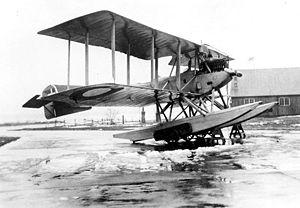
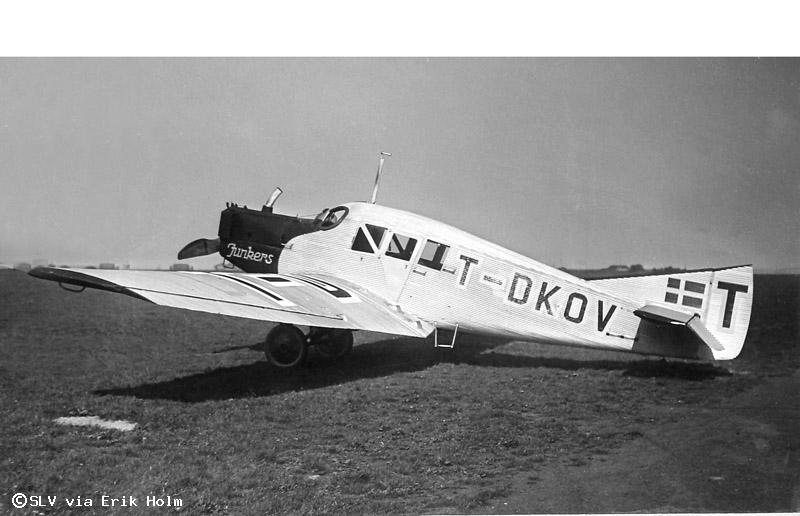
.jpg)
In 1926 the first of a total of four Farman F.121 Jabiru 4-engined commercial airliners, seating nine passengers, were acquired, used on the Copenhagen to Amsterdam line. In 1933, the airline got the first of two 16 passenger Fokker F.XII airliners. In 1938, two Focke-Wulf Fw 200 Condor 26 passenger airliners were acquired. In 1946, the airline started intercontinental traffic in cooperation with Det Norske Luftfartselskap and Svensk Interkontinental Lufttrafik, the other two airlines in Norway and Sweden respectively.
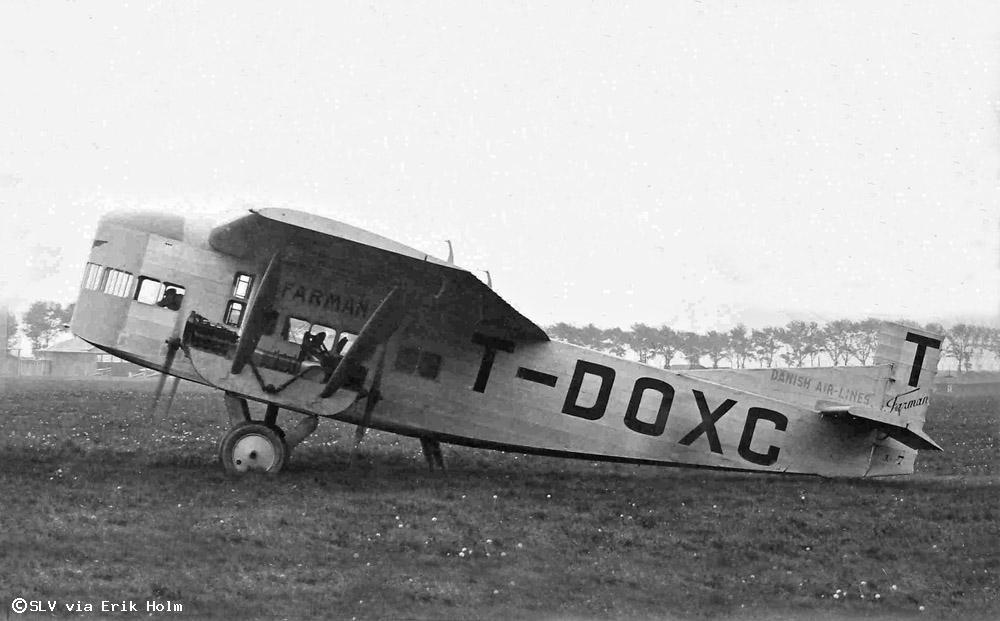
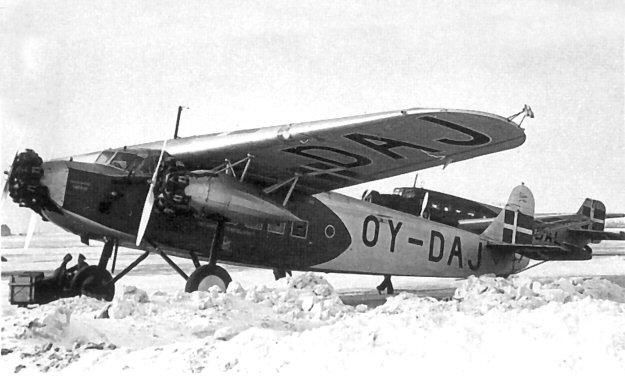
The cooperation between the 3 airlines worked beyond expectations, so it was decided that all their operations should run under one name to better administrative traffic and growth opportunities for all airlines. Scandinavian Airline System was then founded on 1 August 1946, when Svensk Interkontinental Lufttrafik AB (the airline owned by the Swedish Wallenberg family), Det Danske Luftfartselskab A/S, and Det Norske Luftfartselskap AS (the flag carriers of Denmark and Norway) merged together. The original Danish airline, DDL, therefore changed status from being an active airline into becoming a holding company for the Danish interests within SAS. The 3 airlines, (ABA, DDL and DNL) all bought used Douglas C-47 Skytrain from the US Air Force and converted them to civilian airliners. The aircraft were the domestic and European workhorses for the airlines, and served as the main work horses with the establishment of SAS which were delivered from 1948 onwards. Other airframes operated at the time was the Vickers-ArmstrongsVC.1B Viking, Junkers Ju 52/3m and the Short BrothersS.25 Sandringham Mk VI.
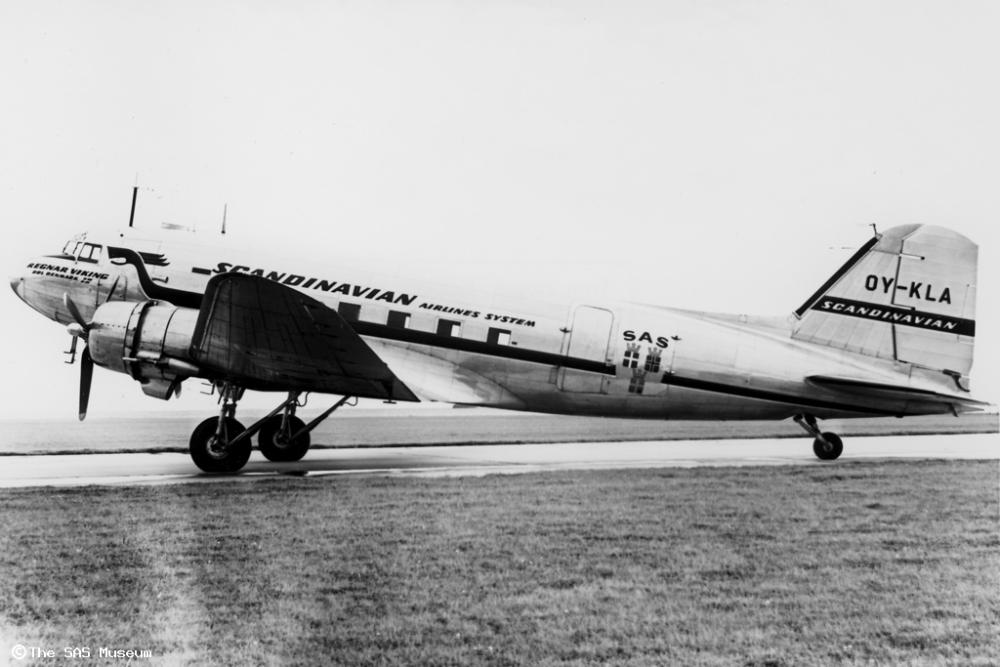
In 1948 the Swedish flag carrier AB Aerotransport joined SAS and the companies coordinated European operations and finally merged to form the SAS Consortium in 1951. When established, the airline was divided between SAS Danmark (28.6%), SAS Norge (28.6%), and SAS Sverige (42.8%), all owned 50% by private investors and 50% by their governments. In 1954 SAS was the first airline to start scheduled flights on a polar route. The DC6B, which were revolutionary at the time were bought and flew from Copenhagen to Los Angeles, California, United States with stops in Greenland and Canada. By summer 1956 frequency had increased to three flights per week. It was popular with Hollywood celebrities and film industry people, and the route turned out to be a publicity coup for SAS.
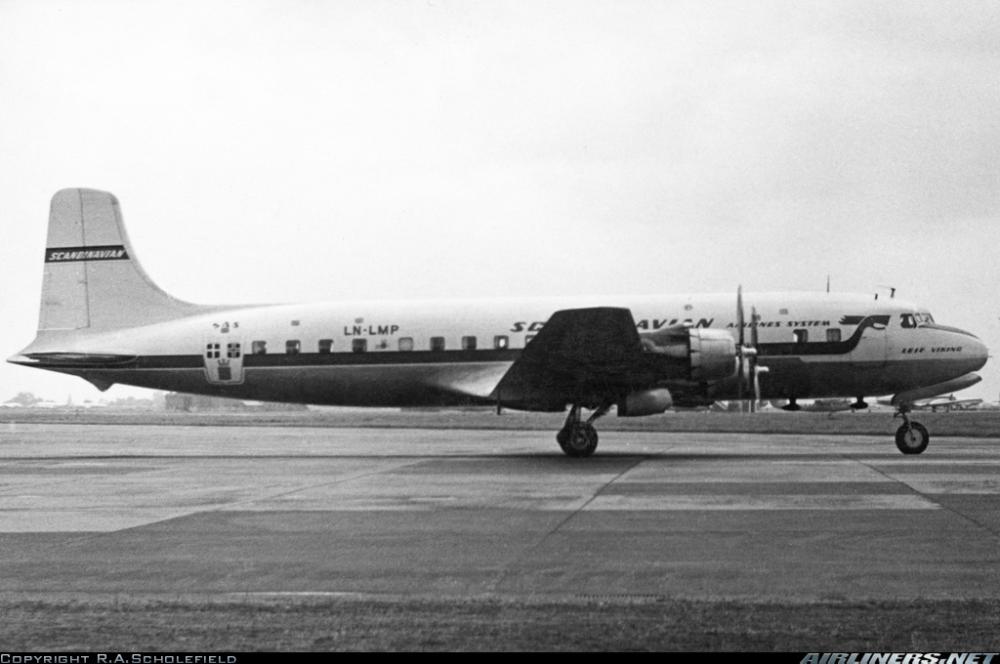
In 1957 SAS started a second polar route when a DC-7C flew from Copenhagen to Tokyo, Japan, via the Anchorage International Airport. SAS entered the jet age in 1959 when the Caravelle entered service, they were at first used on European routes, but were gradually transferred to domestic services, especially in Sweden. Douglas DC-8 then joined the fleet the next year in 1960. The choice of the DC-8 over the Boeing 707 was more based on SAS' good relations with Douglas rather than that it was well-suited for SAS' needs. The jet aircraft tripled the supply of seats on the transatlantic flights, which could not be met with increased traffic. The DC-9 was the first jetliner ordered by the airline for short- and medium-haul flights, replacing the Metropolitans and Viscounts. For its long haul flights it also operated the improved variants of the DC-8-55/62/63 from 1965. It wasn't till 1971, that SAS put its first Boeing 747 jumbo jet into service.
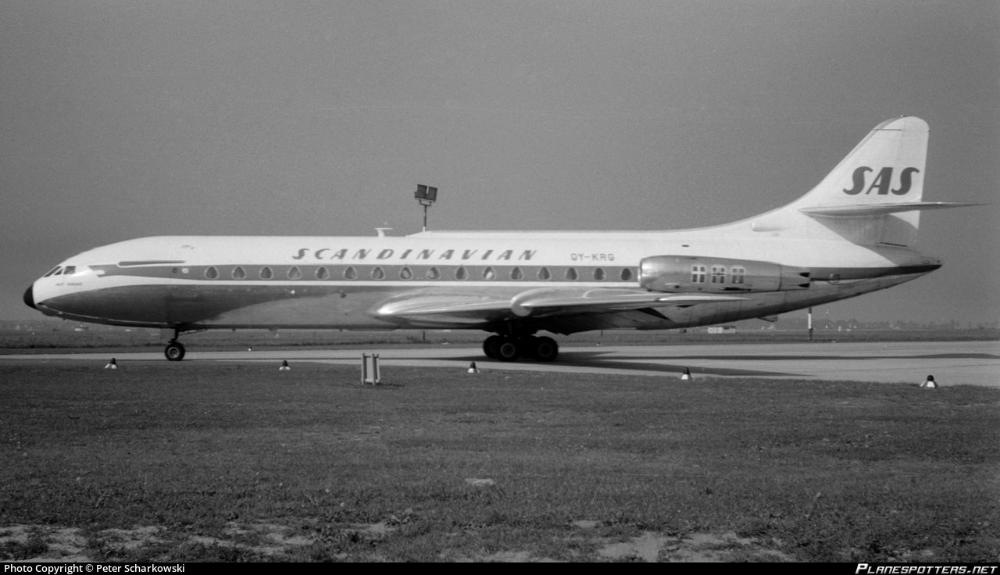
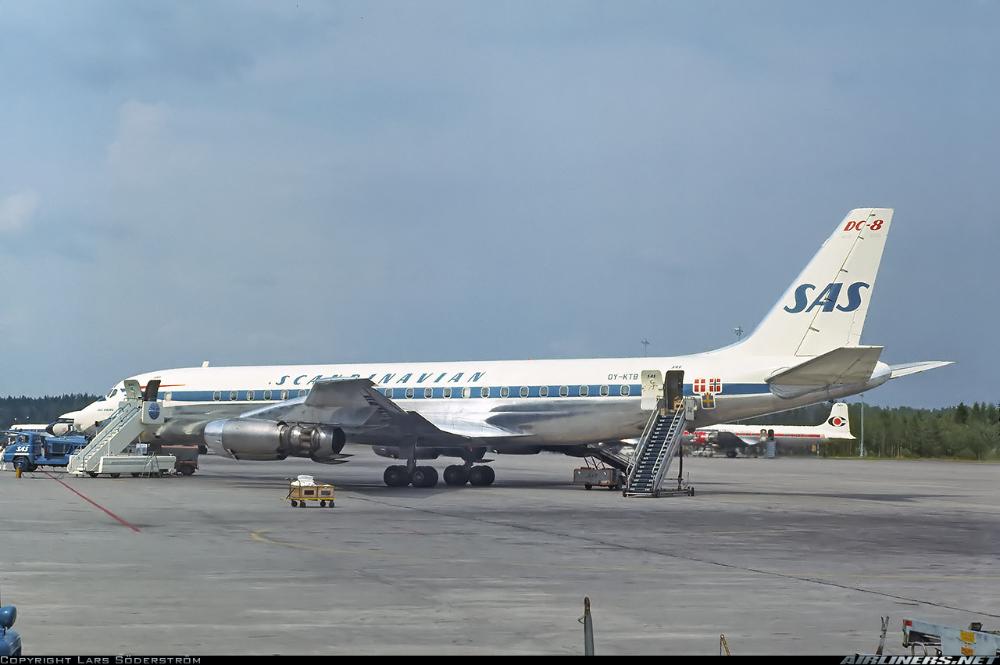
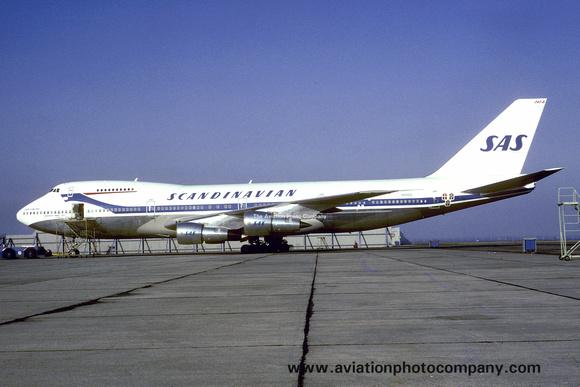
During the 1980's SAS operated a number of aircraft, all of which because of close proximity with Douglas, led it to operate nearly all variants of the manufacturers aircraft, including the DC-10 in 1974, Dc-9-53 in 1983, MD-81/82 in 1985 and the MD-83/87 in 1988. During 1989, SAS also started looking at other planes to help it replace its long haul fleet, so it received in 1989 and 1990 new Boeing 767-300 and -200 respectively.
SAS gradually acquired control of the domestic markets in all three countries by acquiring full or partial control of local airlines, including Braathens and Widerøe in Norway, Linjeflyg and Skyways Express in Sweden, and Cimber Air in Denmark. During the 1990s, SAS also bought a 20% stake in British Midland. SAS bought 95% of Spanair, the second largest airline in Spain, as well as Air Greenland. However there were plans to dispose of all of these holdings and an agreement to divest more than 80 percent of the holdings in Spanair, to a Catalan group of investors.
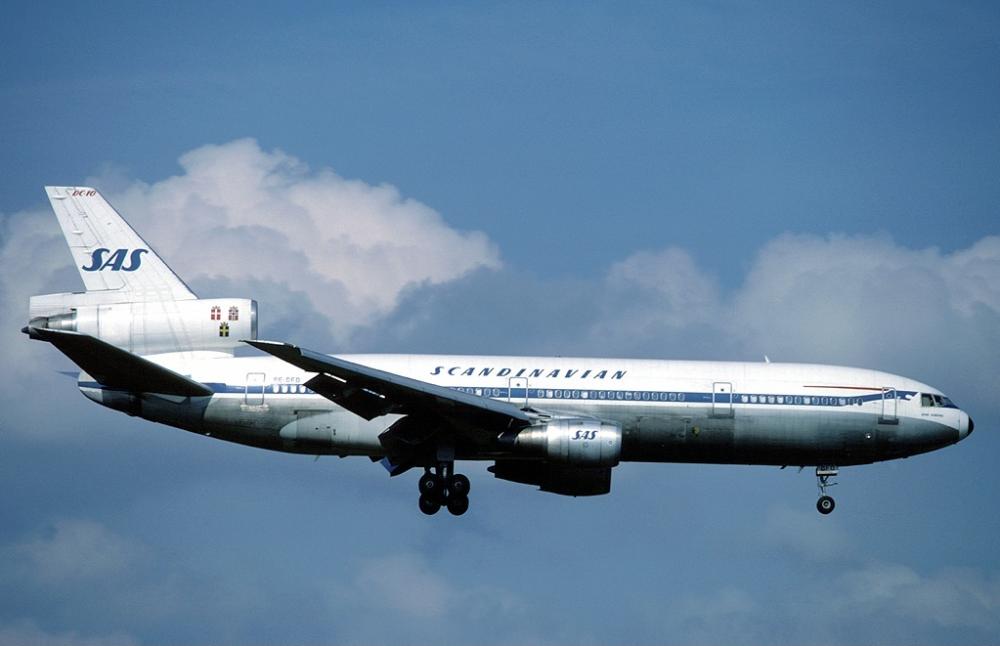
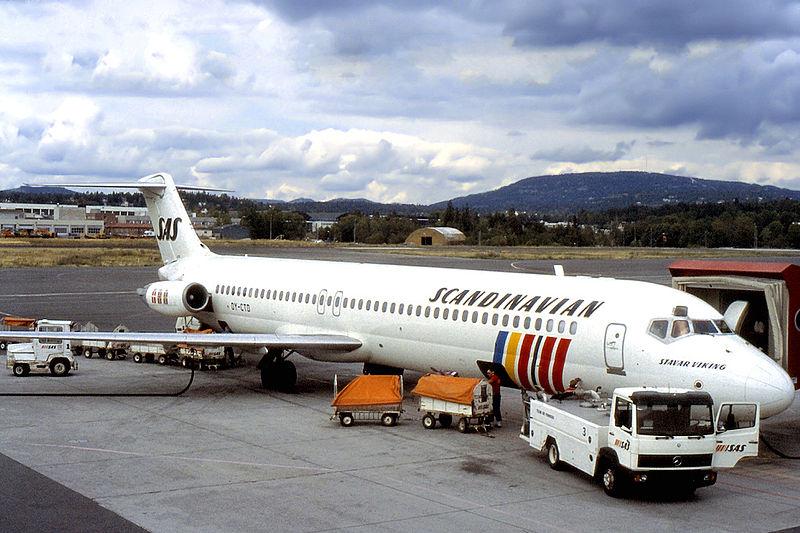
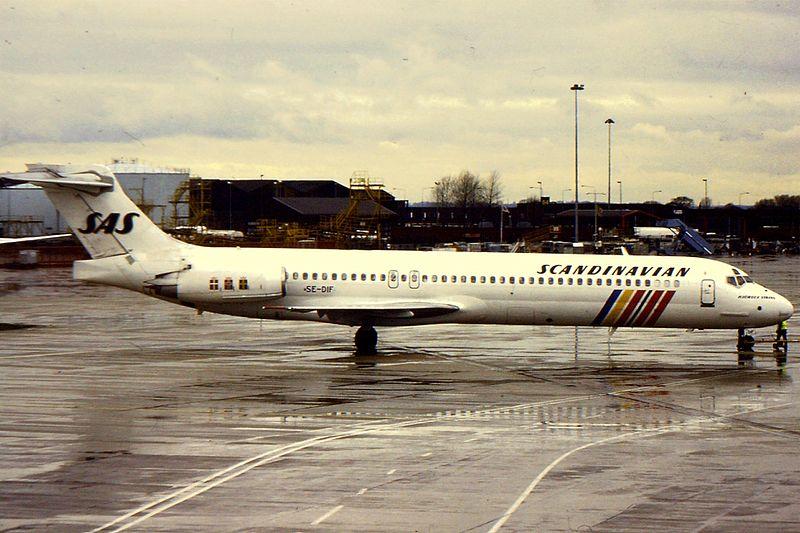
In May 1997, SAS formed the global Star Alliance network with Air Canada, Lufthansa, Thai Airways International, and United Airlines. During the late 1990's SAS took delivery also of other aircraft types to slowly replace the aging MD-82/83/87, these new Boeing 737-600/7/800 arrived from 1998 to 2000 respectively. The ownership structure of SAS was changed in June 2001, with a holding company being created in which the holdings of the governments changed to: Sweden (21.4%), Norway (14.3%), and Denmark (14.3%) and the remaining 50% publicly held and traded on the stock market.
The livery was updated in 1998. SAS aircraft look predominantly white, however, the fuselage is in a very light beige with "Scandinavian" above the windows in silver lettering.
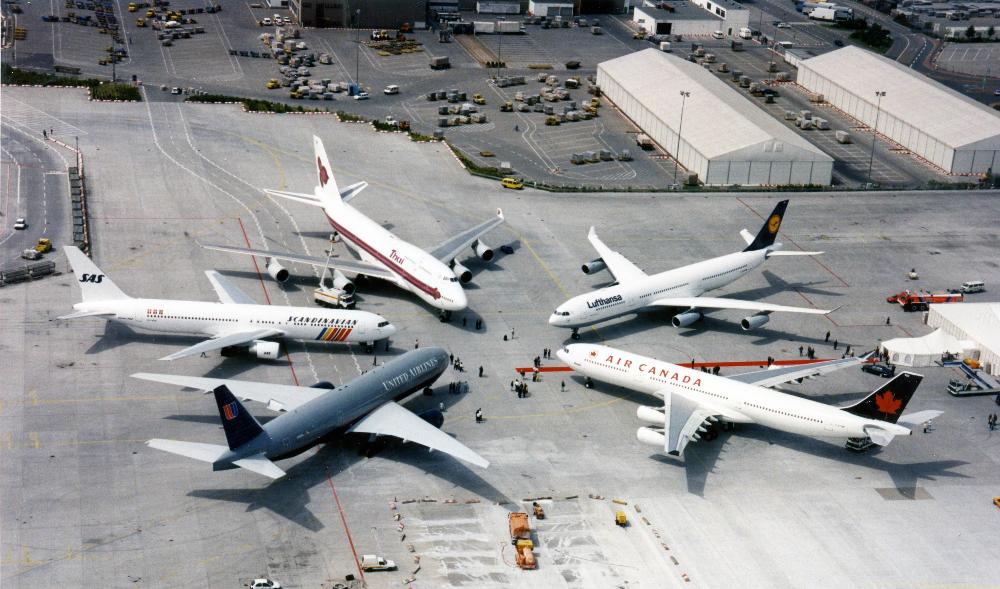
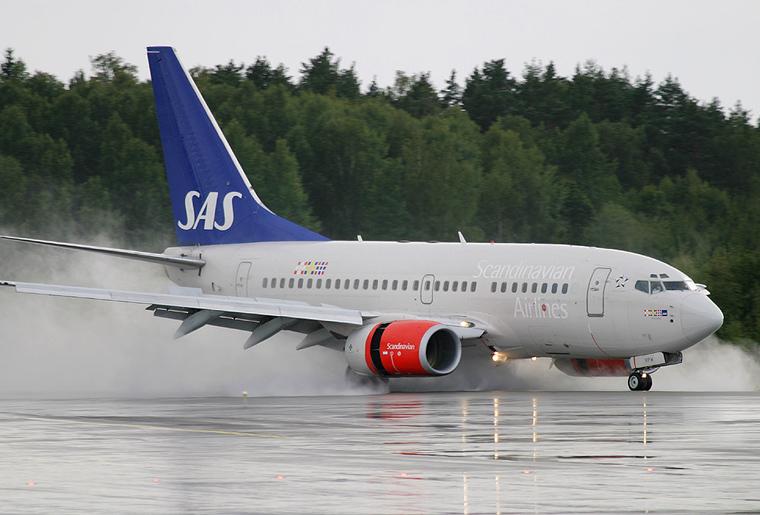
During the turn of the century and the rise of low cost airlines in Europe together with a post 9-11 effect SAS realised it had to act quickly if it wanted to stay at the head of the market. The airline received its first Airbus A321, A330 and A340-300 in 2001 to operate its trunk routes to Europe and the long haul planes for its routes to Asia and America respectively.
In 2004 Scandinavian Airlines System (SAS) was divided into four companies; SAS Scandinavian Airlines Sverige AB, SAS Scandinavian Airlines Danmark A/S, SAS Braathens AS, and SAS Scandinavian International AS. SAS Braathens was rebranded SAS Scandinavian Airlines Norge AS in 2007. In October 2009 the four companies were once again united into one company, SAS Scandinavian System AB. SAS received the first CRJ-900 on 3 December 2008 to operate regional services, in cooperation with it’s regional subsidiaries.
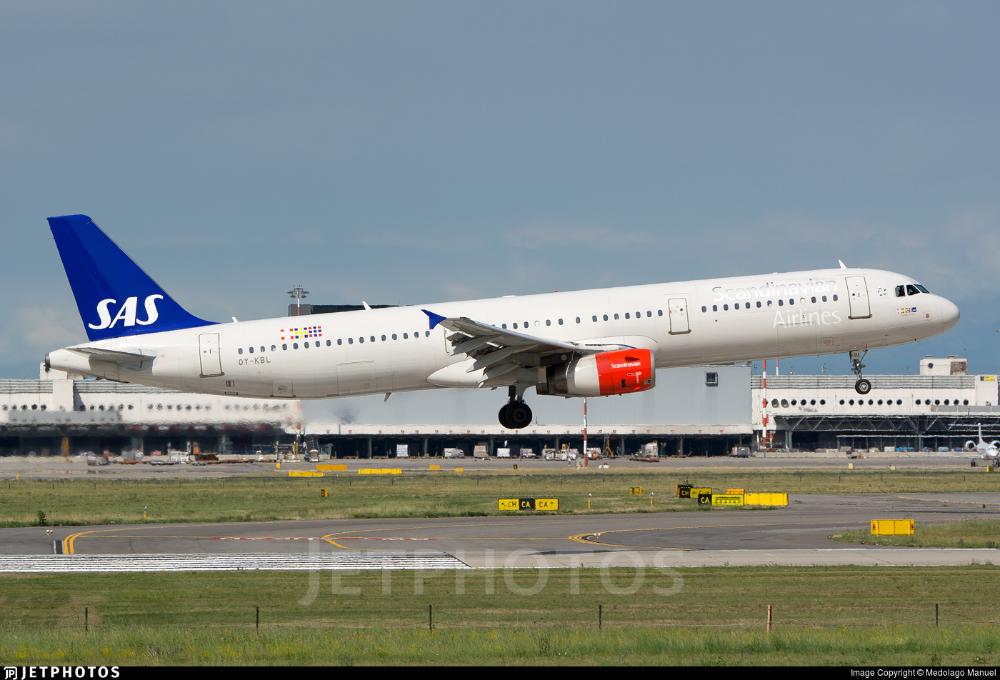
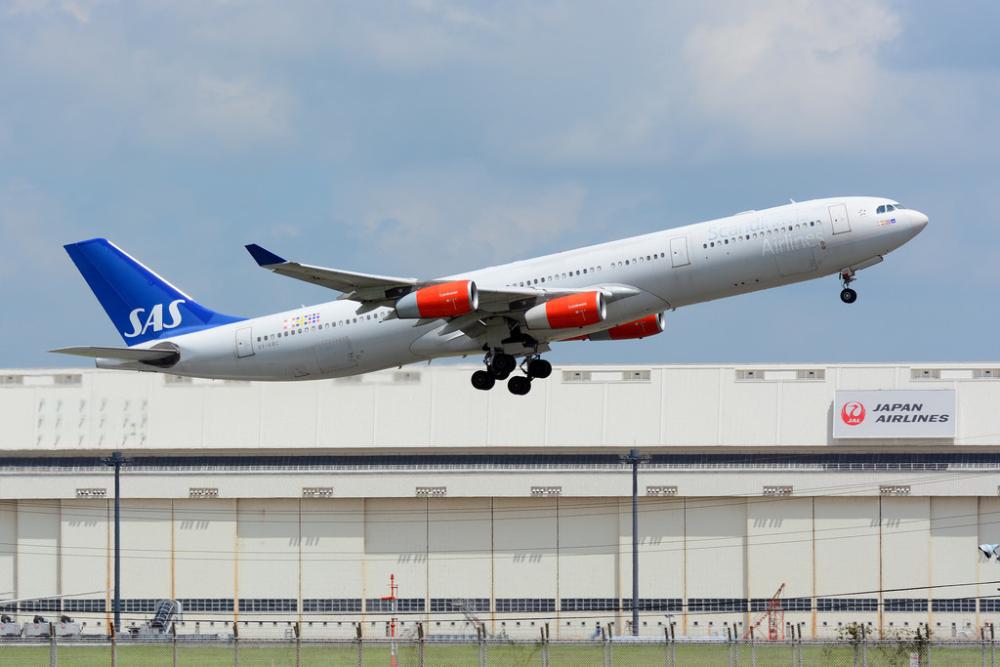
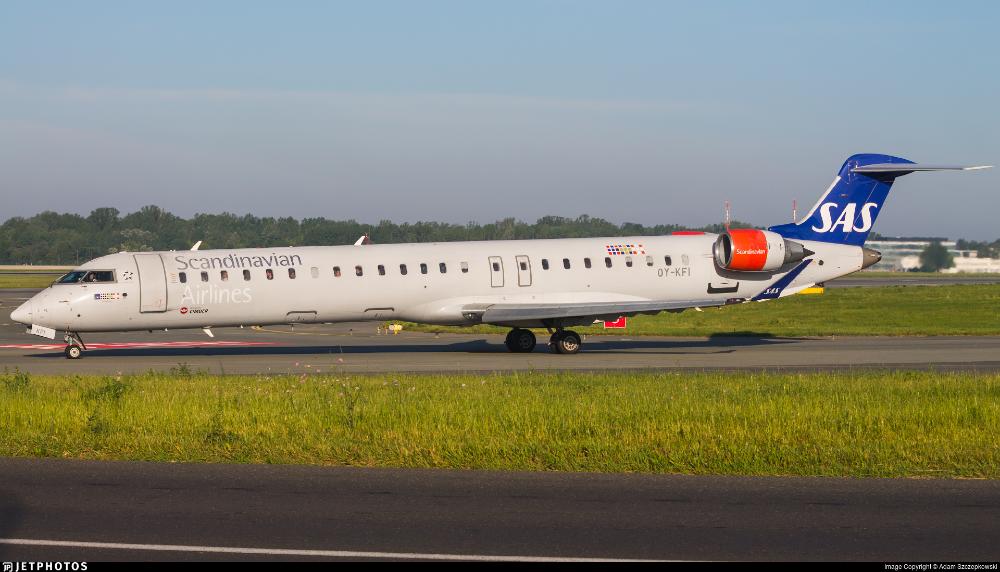
With the coming of low-cost airlines and decreasing fares in Scandinavia the business turned into the red. To be profitable again, the airline had to cut costs. In a first step the airline sold its stakes in other companies, such as BMI, Spanair, and AirBaltic. It also closed it’s handling bases outside of Scandinavia in 2010. The next big cost-cutting measure followed by the end of 2011. On 20 June 2011, SAS announced an order for 30 new A320neo aircraft as part of its fleet harmonisation plan. SAS' stated goal is to have an all-Airbus fleet at their bases in Stockholm and Copenhagen by 2019, with a mixed A320neo and A320ceo fleet operation at both bases. The base in Oslo will then operate mostly Boeing 737-800 aircraft. On 25 June 2013, SAS ordered eight A350-900 with six options, and four A330-300E, originally planned to replace the aging A340-300 in 2015.
Despite high load factors, SAS suspended its flagship route between Copenhagen and Bangkok over the summer months of 2013. This route was served without any interruption over the last sixty years. On the other side, SAS renewed the leasing agreements to be able to expand its long-haul fleet and used the new A330-300Es to add more long-haul destinations to its network to the USA. As of November 2013, there was the expectation that the company would show 2013 as its first profitable year since 2007.
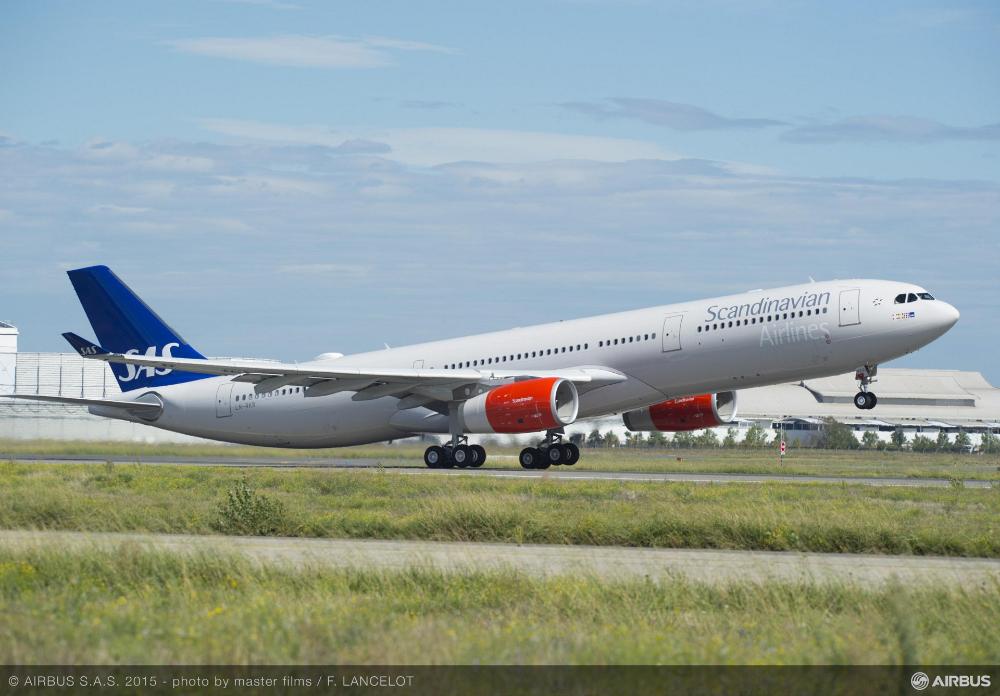
In 2017, it was announced that SAS would form a new airline, Scandinavian Airlines Ireland, operating out of Heathrow Airport and Malaga Airport to fly European routes on its parent’s behalf using nine new A320Neo aircraft. The first of the order of A320neos was delivered in October 2016. In April 2018, SAS announced an order of 50 more A320neos to replace all 737NGs and older A320ceos in service as part of their goal to have an all-Airbus fleet by 2023.
SAS received its first of eight A350-900 versions of the A350 XWB in November 2019, with the Scandinavian carrier targeted to introduce Airbus’ latest generation, highly efficient widebody aircraft on the Copenhagen-Chicago long-haul route followed by other cities in North America and Asia.
SAS has always been an airline for innovation and leadership and so is trying to continue in the current markets with increased competition from low cost airlines. It continues to attract important business between USA and Asia where it has a strong position. As it modernises it's fleet and rolls out WiFi on board it's aircraft it's looking forward for many more years of bright success.
History source: Wikipedia.org + flysas.com
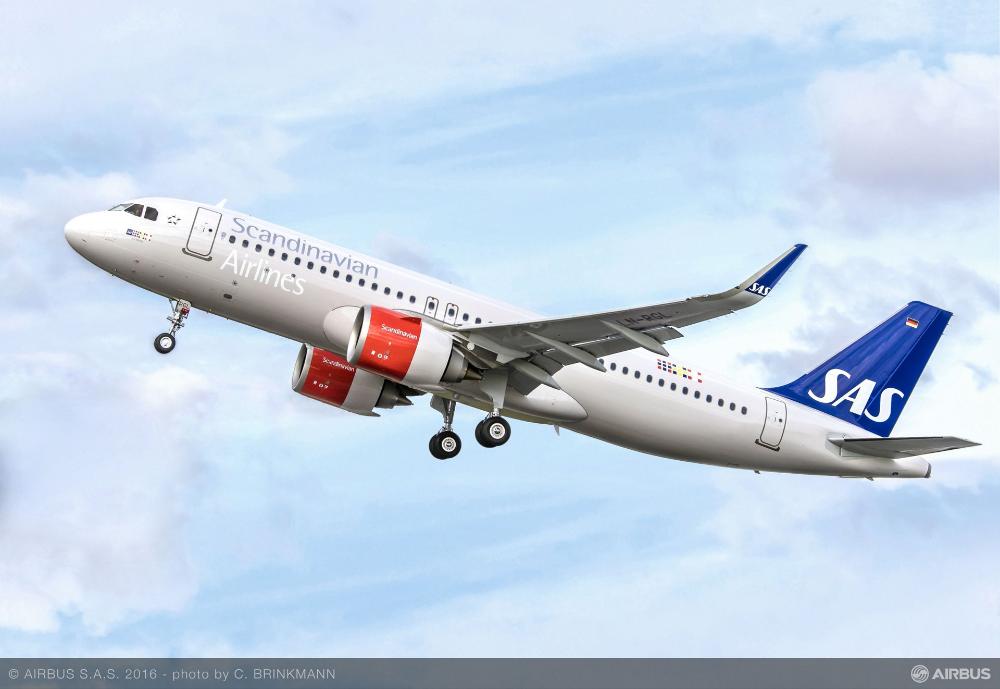
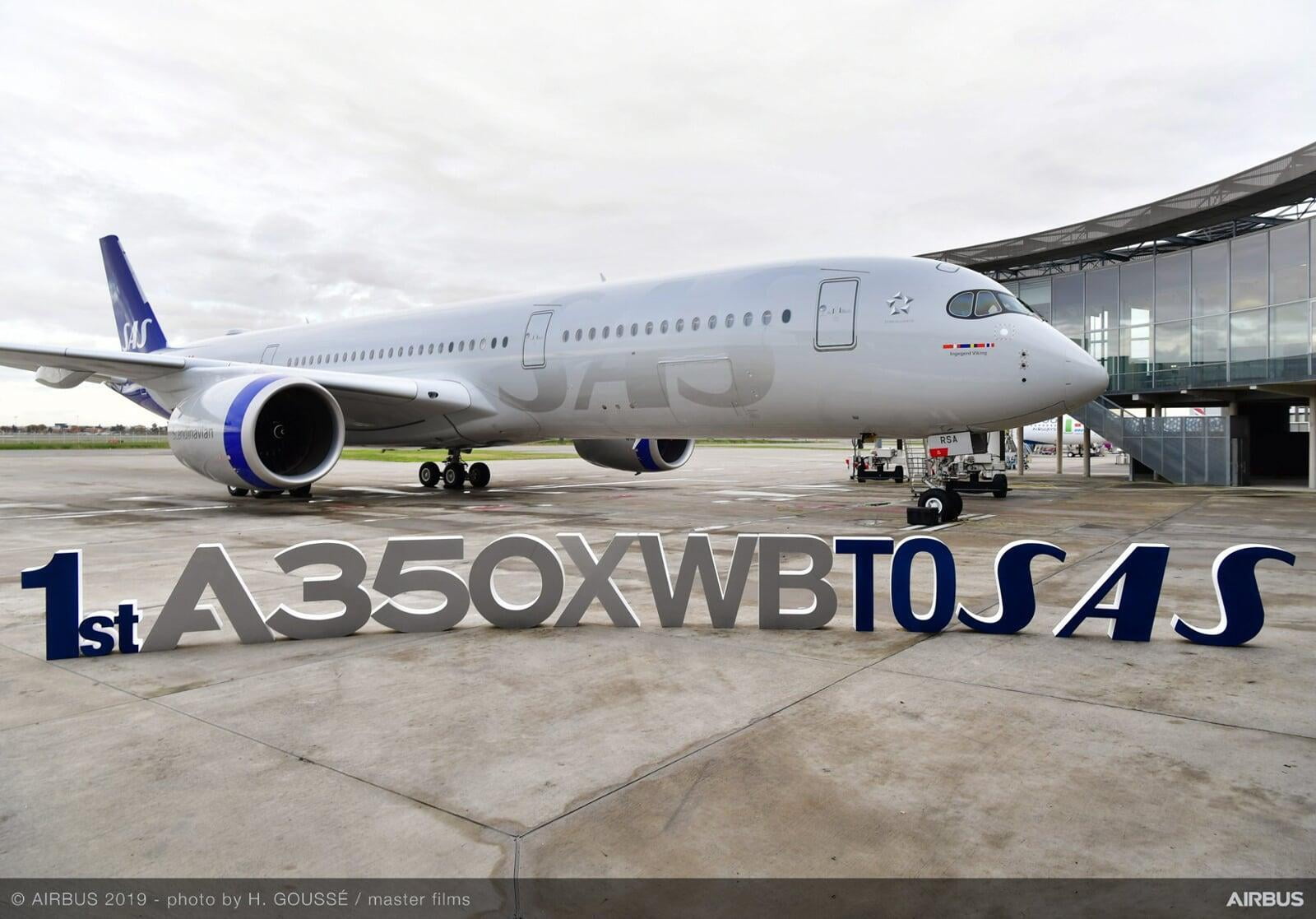
Operations and Destinations 🌍:
SAS flies to 123 destinations around the world. The airline's main hub is at Copenhagen Airport, with connections to over 50 cities in Europe. Also, a secondary hub at Stockholm Arlanda Airport (with more than 30 European connections) and another hub at Oslo Airport. Other focus cities include also Bergen, Flesland, Göteborg, Stavanger and Trondheim where SAS has a major presence. It attracts a lot of inbound connections for its long haul flights from central Europe, the Baltics and Eastern Europe towards its long haul flights to North America and Asia. SAS has internal agreements with several smaller regional airlines which operate on behalf of SAS, these airlines are Cimber Sterling, Jet Time, PrivatAir, and Widerøe.
In the last few years SAS has expanded its presence in the North American continent and making its tickets more appealing and affordable to compete with new competition, specially in the low cost markets. Its products now includes a Business Class or a Economy cabin, where you can select basic fares which include only hand luggage and add extras at a later stage if purchasing basic economy fares. SAS has a strong passenger service reputation and an efficient handling service making the airline one of the most punctual airlines in Europe.
SAS flies to the following destinations* including those operated by its regional subsidiaries:
| Region 🗺️ | Destinations 🌍🌎🌏 |
|---|---|
| ✈Scandinavia (Denmark, Norway, Sweden) | Denmark: Aalborg, Aarhus, Billund, Copenhagen Norway: Ålesund, Alta, Bardufoss, Bergen, Berlevåg, Bodø, Harstad/Narvik, Haugesund, Kirkenes, Kristiansand, Kristiansund, Longyearbyen, Molde, Oslo, Stavanger, Tromsø, Trondheim Sweden: Ängelholm, Gothenburg, Kalmar, Kiruna, Luleå, Malmö, Örnsköldsvik, Östersund, Ronneby, Skellefteå, Stockholm, Sundsvall, Umeå, Visby |
| ✈Europe and Russia (excluding Scandinavian countries) | Aberdeen, Alanya, Alicante, Amsterdam, Ankara, Antalya, Athens, Barcelona, Berlin, Biarritz, Birmingham, Bologna, Bremen, Brussels, Bucharest, Budapest, Cagliari, Dublin, Dubrovnik, Düsseldorf, Edinburgh, Faro, Frankfurt, Gdańsk, Geneva, Hamburg, Hanover, Helsinki, Kraków, Las Palmas, Lisbon, London (LHR, LGW), Luqa, Luxembourg City, Madrid, Málaga, Manchester, Milan, Milan, Montpellier, Munich, Nice, Palanga, Palermo, Palma de Mallorca, Paris, Poznań, Prague, Pristina, Reykjavík, Riga, Rome, Shannon, Sørvágur, Split, Stuttgart, Szczecin, Tallinn, Tampere, Thessaloniki, Turin, Turku, Venice, Vilnius, Warsaw, Wroclaw, Zurich, Kaliningrad, Saint Petersburg |
| ✈America | Boston, Chicago, Los Angeles, Miami, Newark, San Francisco, Washington, D.C. |
| ✈Asia | Beijing, Hong Kong, Phuket, Shanghai, Tokyo |
| ✈ The Middle East | Beirut, Eilat |
*Destination list is for reference only. Please check directly with the airline for updates.
*Note some destinations are only seasonal.*Correct info as of Jan 2019..
Fleet ✈️:
The fleet which SAS currently flies is in a big transition at the moment to transform itself into an all Airbus fleet by 2023. At present the airline totals a fleet of 160 aircraft. It does have however a majority of Airbus planes in operation for short, medium and long haul. However its planes based in Norway are Boeing 737-600/700/800 for short haul flights to be retired by 2023. It also has regional aircraft which are operated under SAS subsidiary airlines.
The current fleet* of SAS Scandinavian Airlines consists of the following aircraft:
| Network 🌐 | Aircraft ✈️ |
|---|---|
| ✈Short haul (domestic) and regional | Airbus A319, A320. CRJ-900/1000. ATR-72-600, Boeing 737-600/700 (to be replaced by 2023) |
| ✈Short haul (International) | Airbus A320Neo, A321. Boeing 737-800 (to be replaced by 2023) |
| ✈Long haul | Airbus A330, A340-300, A350-900 |
*Correct fleet info as of Mar 2020.
Scandinavian Airlines Photo Slide 📷:
Reviews ⭐:
 |  |
|---|---|
| ✅ Best airline to fly to Scandinavia and trans-polar routes. | 👎 Limited routes to Asia (and termination of popular routes like Bangkok) |
| ✅Effective connecting flights in Copenhagen, Stockholm and Oslo airport. | 👎Basic fares on short haul only include hand luggage |
| ✅ Member of the Star Alliance for mileage redemption. | 👎Only 2 classes of service offered on long haul flights. (Business and Economy) |
| ✅ Inclusive in the ticket: Baggage and meals on long haul flights. (tea/coffee only on short and medium routes in Economy). | |
| ✅ Free online check-in and Seat selection 24h before the flight. | |
| ✅Reliable airline during Winter months, operating during snowing and sub-zero conditions. | |
| ✅Good airport service and ground handling with a good punctuality record. | |
| ✅Friendly and efficient on-board service |

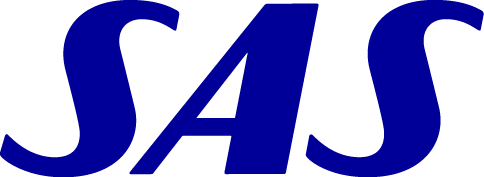





.png)